Social media has bricked the way for companies to bring relationship with their customers closer. And while this is advantageous, it can also be a disaster if you do not efficiently deal with angry customers who vent their irritation and disappointment publicly on Facebook ads.
Not many years back, bad feedback or customer complaint may have gone no further than a conversation between friends or through snail mail. With people becoming more social media literate, every criticism, valid or not, is available for the world to see! And you do not want to be on the wrong side of things.
If you are providing a service, your customers will complain that's simple.
According to research, 13% of unhappy customers will share their complaints with 15 or more people. At the same time, only 1 in 25 low customers complain directly to the brand.
Disappointed customers can be a lot to deal with first, more so when they vent through social media. So approach the matter with sensitivity.
How you handle customer complaints on Facebook ads can be a make or break for your brand reputation. Remember, an angry customer has the potential to be your loyal fan and brand advocate if treated rightly.
Why Facebook ads
Below mentioned are 5 reasons why Facebook ads are best form of advertising.
1. Most Targeted Form of Advertising
A significant benefit of Facebook advertising is its ability to reach your exact audience. If you know your customers, you can use Facebook advertising to engage them.
2. Cheapest Form Of Advertising
You can approximately spend $5 and reach 1,000 people. It does not make sense to pay more in radio ads, television commercials, billboards, and other traditional media to get the same audience.
3. Fast
It drives fast and immediate results. You can start reaching thousands of people the same day. So if you are looking for a quick way to drive engagement, Facebook advertising is the best solution.
4. Measurable
Facebook advertising results are measurable. The numbers will speak for themselves. You will calculate and see how many impressions, clicks, and conversions you are receiving. You can either use Facebook analytics or a social media management tool like Statusbrew to measure your performance.
Example below illustrates engagement on a paid facebook performance using Statusbrew reports.
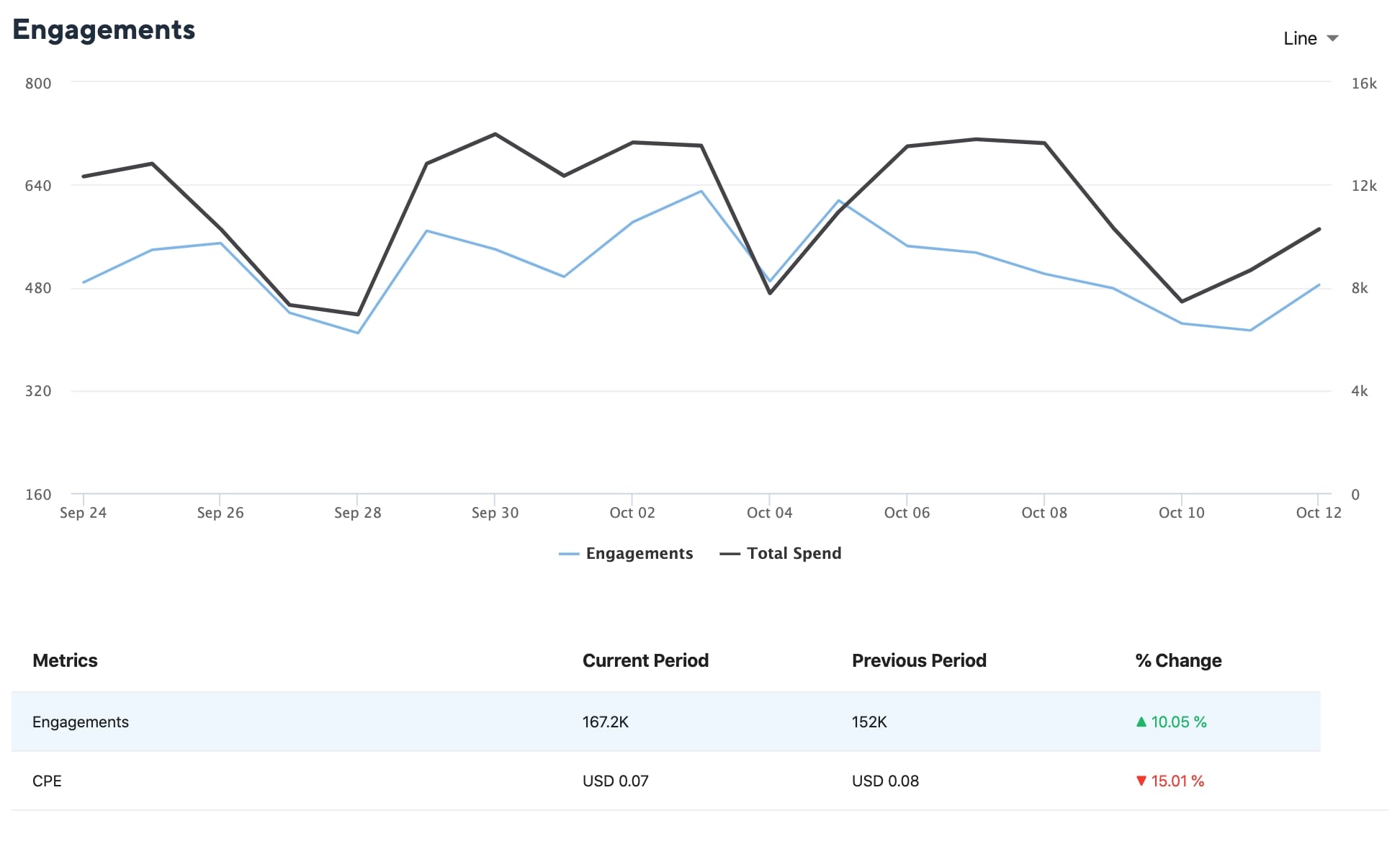
5. Increases Customer Attribution
Attribution means the number of times your audience is seeing your brand. The more times they interact with your brand, the more likely they will convert. Facebook advertising will help you increase your involvement with your audience and leads to more conversions in the future.
How To Handle Customer Complaint Checklist
No matter how good service you provide, you cannot please all the people, all the time. So, next time you receive any complaint, keep a checklist handy for reference.
Your checklist may include steps like:
- Acknowledge the complaint
- Inform the customer that you are taking action
- Record and categorize the customer complaint
- Resolve the complaint according to company policy
- Follow up with the customer to make sure that the issue has been resolved
Facebook ads can help you reach over two billion people, which means Facebook ads provide a fantastic opportunity for your brand to display a professional and courteous attitude in the public forum.
Whether you're attending or not, the conversations around your product or industry, or brand are happening. A good social listening tool makes it easier for you to catch the negative buzz and spot issues before building momentum and becoming difficult to turn around.
Learn how social listening is important to get ahead in changing market dynamics.
Through the tips below, we will learn valuable ways to efficiently deal with customer service on Facebook ads
1. Have A 'How To Handle Customer Complaints Policy'
Ensure your brand has adopted a social media engagement policy, including detailed information regarding how the brand will address customer complaints. Having a good policy in place helps to ensure that customer complaint is dealt proactively and professionally.
The goal of the guidelines and policies should solve the below-mentioned scenarios:
- Turn a dissatisfied customer into a satisfied customer
- Align your customer service team's response and actions
- Analyse areas of your business to improve experiences
2. Address All Complaints
No comment or complaint a customer posts about your company should go unnoticed, and no question should go without a response from the brand.
To illustrate this, consider the example below of Starbuck's response to a customer complaining about not having a caffeine-free option for kids.
Starbucks answered a customer's questions, and, in return, the customer was appreciative of the received information.
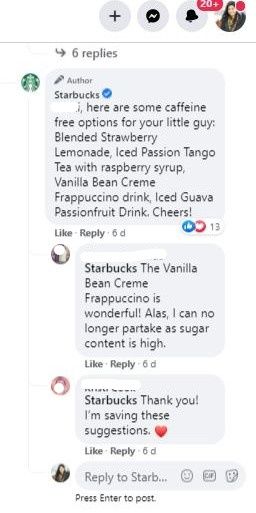 Source: Facebook
Source: Facebook
By listening and addressing the customer's feedback, Starbucks demonstrated that the brand pays attention to its customers. Moreover, the company answered the question and went the extra mile to provide some additional information. That was undoubtedly worthy of the "thank you" they received.
3. Respond Publically And Then Take Conversation Private
An acceptance and apology should be your first response, followed by empathy, then a further probe, solution, or an offer to the customer.
Example of an apology in response to a complaint:
We'll notify you right away when it's fixed. We appreciate you making us aware of the negative experience you have encountered with us. We strive to provide excellent customer service promptly, and I apologize for the inconvenience this incident has caused. Please let us know if you have any additional questions, concerns, or comments using a private message.
Don't underestimate the power of an apology! A research has found that unhappy customers are more willing to forgive a company that offers an apology instead of being compensated.
Don't delete complaints. Leave the complaint on your Facebook ad to show other customers that your business takes customer concerns seriously and gives a solution.
Respond to the complaint acknowledging the customer, apologize for the issue and offer to rectify it. Ask the customer to contact you via email, DM on Facebook, or phone. Better yet, request the customer to email you contact details to get information to contact him directly.
Stay calm and professional in both public response and your one-on-one interactions with the customer. This is important. No matter how insulting a customer may become, there is no benefit in engaging in a heated exchange.
Example below illustrates how ecommerce brand Flipkart handles angry customers.
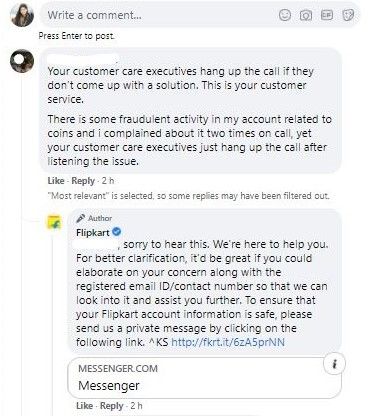 Source: Facebook
Source: Facebook
4. Respond Quickly
A study by Harvard found that customers who have their complaints handled anywhere in less than 5 minutes go on to spend more on future purchases. 42% of consumers expect a response with 60 minutes.
Customers can see a Facebook ad 24/7, which means they can write a compliant 24/7. They feel they also have the right to be attended to 24/7.
Even when you don't have any solution or complete answer to the complaint, letting them know that the complaint has reached you can control the possible spread of negative buzz around the brand.
Remember, the longer irritated customers are ignored, the angrier they get, and the possibility of them ranting on social media with more people picking up on the issue multiplies a hundredfold.
5. Keep A Personal Touch
The only thing worse than ignoring already upset customers is to respond with a canned corporate response! When you respond to a customer, use their name. Communicate in a friendly tone.
6. Follow Up
Follow up with your customers who filed a complaint to make sure they are satisfied with the solution. Follow-ups can be in the form of a follow-up email or survey asking for feedback on how the complaint was handled.
Next Steps
The social media literate customers share their feedback across multiple channels. Without being proactive, the feedbacks can snowball and even go viral. This means there is a need to engage in a good social listening tool and get proactive in handling a customer complaint.
Finding complaints online over all social networks is not easy, but here are a few suggestions from Statusbrew on where to start.
- Has your brand name been mentioned anywhere on social media?
- What is the sentiment (Positive, Neutral, or Negative) of your brand?
- Do customers post messages on your Facebook brand page?
- Has anyone left a bad review on your Google My Business page?
- Are the comments made on your YouTube channels positive?
All the social channels should be monitored. If you don't respond efficiently, customers will assume you don't care about their feedback. If you respond to comments online on ads, it can be seen as though you are making an effort and that you do care for them. This act alone can inspire brand loyalty and customer confidence.
Benefits Of Using Statusbrew's Ad Comment Management For Customer Care
At Statusbrew, we realized the need for the best ad comment management solution and made a one-stop destination for brands to manage Facebook ad comments all under a single tab.
Although facebook ad comment management is a complex process but Statusbrew eliminates the everyday hassle of handling customer complaints for the senarios mentioned below:
- Manage customer comments for multiple ad campaigns
- Create a custom inbox for all your ad comments (Facebook and Instagram)
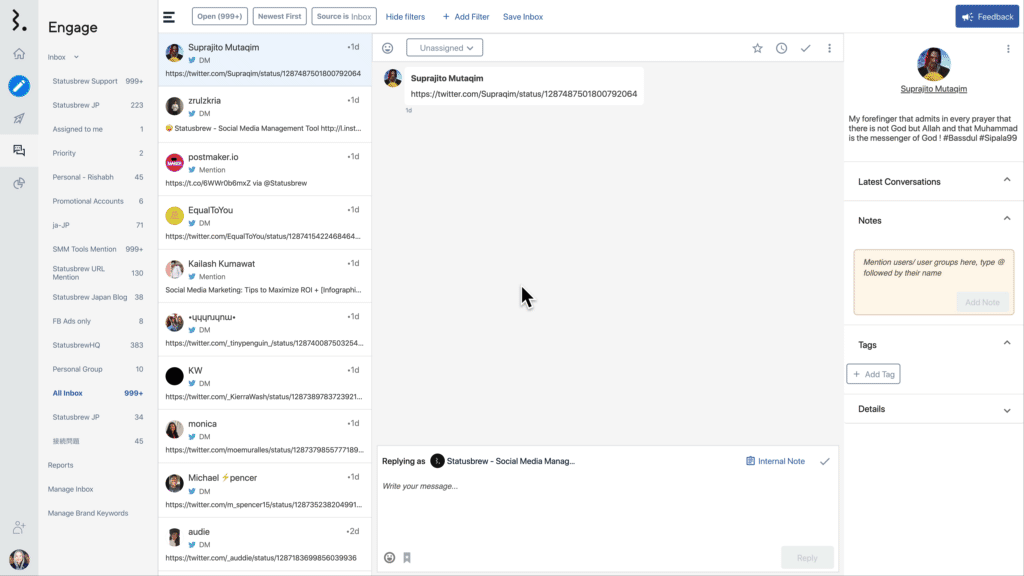
- Manage hundreds of comments in one place
- Hide the comments you don't want your other customers to see
For example, look how Amazon wants to hide the customer's personal information.
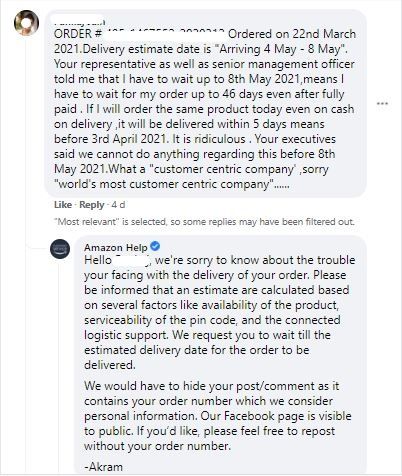 Source: Facebook
Source: Facebook
- Separate sections for comments of regular posts and ad posts
- Filter ad post comments from the regular ones
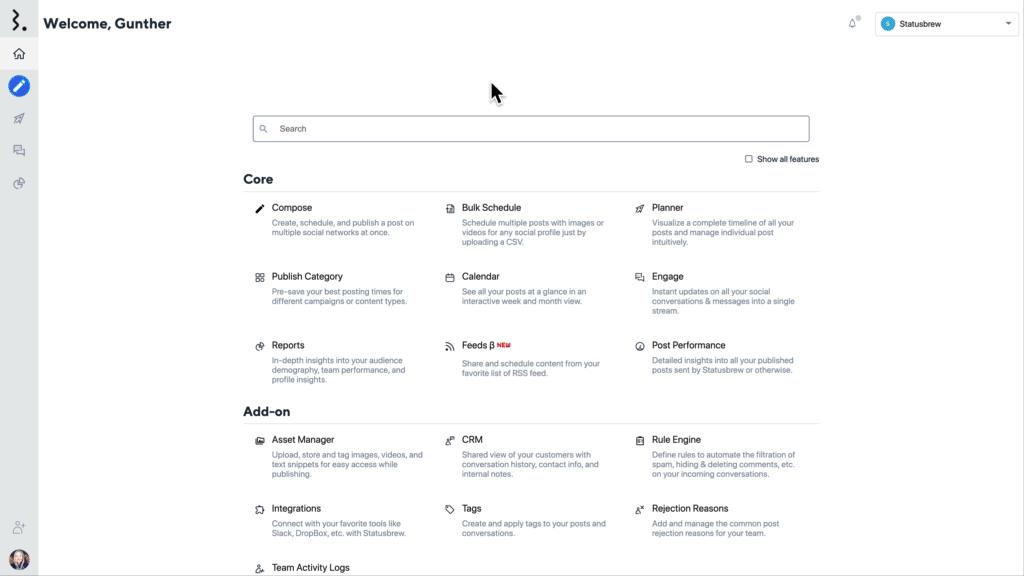
- Respond to every single comment
- Get rid of spam comments from unwanted elements
- Manage Facebook ad comments with your customer care team by assigning workflow and responsibility among team members
Use Statusbrew to nurture customer relationships like never before.




Explore the Statusbrew range of social media tools
Cancel anytime!